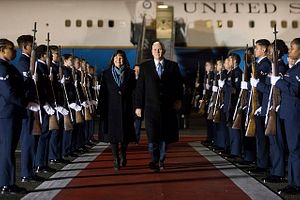In early November, U.S. Vice President Mike Pence visited Japan where he met with Japanese Prime Minister Shinzo Abe. The meeting produced the following statement, announcing a policy of massive development financing, infrastructure projects and investments in energy-related infrastructure in the Indo-Pacific. The announcement may very well mark the end of rhetoric and the start of a new era of true competition in this strategically vital region.
“For our part, the United States has more than doubled our ability to support private development projects in emerging economies. My nation now offers $60 billion in development financing, and infrastructure projects in the Indo-Pacific will be a priority for the United States of America. We’re also grateful, Mr. Prime Minister, that Japan has targeted $10 billion in investment by public and private organizations to promising energy infrastructure projects. And the United States looks forward to working closely with Japan to identify the most promising projects in the region.”
What this means is that Japan and the United States combined will invest a total of $70 billion in the Indo-Pacific. Meanwhile, Chinese President Xi Jinping has already declared at the Forum on China-Africa Cooperation (FOCAC) that his country will invest $60 billion (including private investment) in African countries. China will also provide extensive support and investment for the Pacific.
One of the reasons why the Chinese Belt and Road Initiative has been of such significance for the huge area that stretches from Eurasia to Africa to the Pacific was that support and investment from developed countries, especially the United States, had been declining dramatically, and anyway tended to come attached with burdensome requirements associated with democratization and human rights. Infrastructure demand in Africa and the Asia-Pacific is enormous. Funds from developed countries, the Asian Development Bank and the World Bank are not sufficient to meet this demand. Chinese money was needed. In addition, even if the interest rates were high and the quality of the structures built with the funds somewhat questionable, Chinese projects were all the more welcome because of the absence of political conditions and their simple, straightforward procedures and short construction periods. Indeed, Chinese funds were often the most attractive option for developing countries in the region.
For this reason, Chinese investment was expected to continue over the long term, even in the face of growing criticism of the Belt and Road Initiative in the West and mounting concerns about China’s own economy in the face of trade friction with the U.S. However, with Washington and Tokyo preparing to make hefty sums available, countries in this region now have a choice between continuing an all-out commitment to China or receiving major new support from the United States and Japan.
This could help the U.S. make up lost ground, but it won’t necessarily be easy. First, as the example of Cambodia shows, Washington has in recent years restricted its support for countries that it deems authoritarian. China has been quick to step in and take advantage of this, bolstering its relationships with those countries. How will the United States deal with authoritarian states going forward? Second, will US support be provided without conditions attached, or will it again come with demands on democracy and human rights? Low interest rates are certainly one appealing factor, but recipients will also look at other aspects of the financing, such as the amount on offer, the speed of decision making, the presence any conditions, and the speed of construction. It will not be easy to gain an edge over China in these areas.
At any rate, support from Japan and the U.S. will give developing countries in the region new options. Japan, the United States and China, as donors, will be competing with each other. Chinese infrastructure investment has already been closely linked with the formation of a new order in the region. Can Japan and the United States move the direction back in favor of the old order?
For Japan, it seems that the United States may have finally decided to shift its Free and Open Indo-Pacific (FOIP) concept, hitherto only a nominal strategy, into high gear. If so, Japan must work with America. This is a situation that Tokyo had been anticipating for many years. Yet when Abe visited China in late October, the two leaders discussed more than 50 Japan-China business cooperation projects in third countries. Abe did not announce that Japan would cooperate in the Belt and Road Initiative, but he did strengthen engagement with China. As such, Japan will work conditionally with China, encouraging the country to comply with the existing international order on the one hand, while promoting the FOIP Strategy as a significant policy in cooperation with the United States on the other hand. This stance is actually quite similar to a previous U.S. engagement policy, and the Abe administration will find itself having to explain its stance to both domestic and international audiences.
Shin Kawashima is a professor at the University of Tokyo.

































